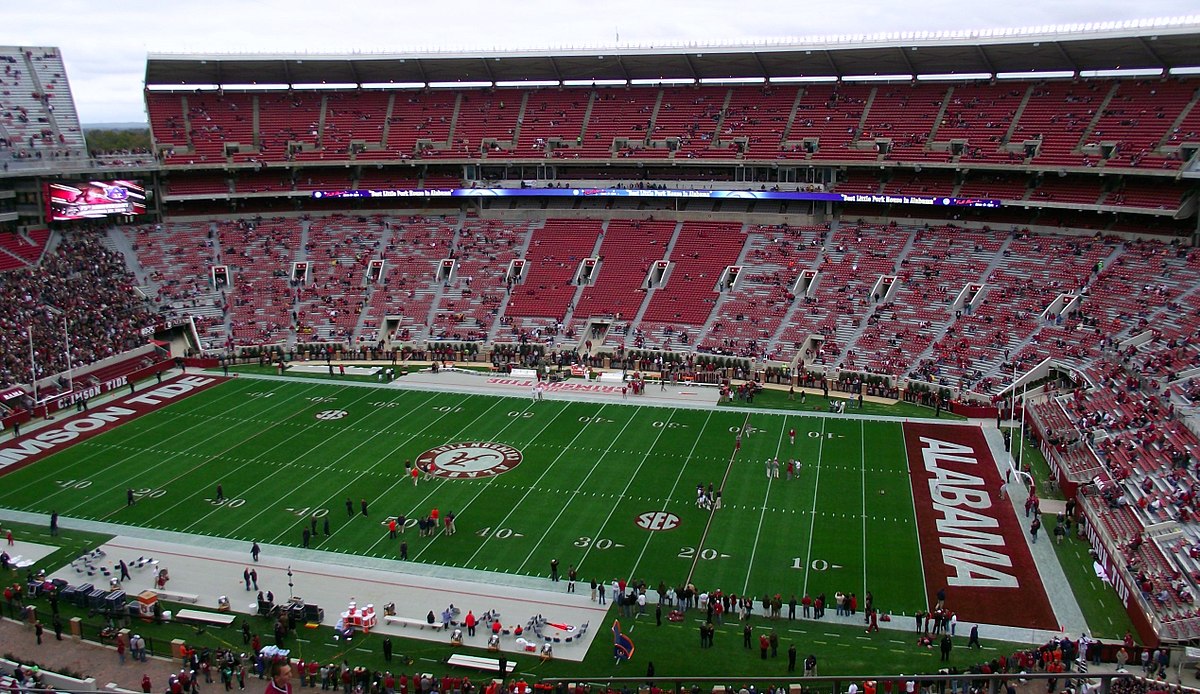Bryant-Denny Stadium Information
Below are useful links for further information on Bryant-Denny Stadium:
Parking Information:
Arriving by car? Read about parking options on the Bryant-Denny Stadium parking information page.
Ticket Policy Information:
For information on ticket guarentees and other ticket related questions, view the Bryant-Denny Stadium tickets page.
Seating Information:
For information on accessible seating and to view the Bryant-Denny Stadium seating chart page.

Bryant-Denny Stadium is the fifth largest college stadium in the nation; located in the southwestern edge of The University of Alabama campus. The history-laden stadium acts as the home stadium for the University of Alabama Crimson Tide football team. However, it took nearly four decades before the team began to play at Bryant-Denny Stadium.
This mega football stadium was built in 1929 when the University of Alabama finally decided that they needed a new football facility and thus, built the original stadium for 12,000 seats. Crimson Tide football team christened the stadium on September 28, 1929. The first official game was on October 5, 1929, against Mississippi. At that time, this grass surface stadium’s name was known as George Hutchenson Denny Stadium.
The stadium was initially named after Dr. George Hutcheson Denny (1870-1955). He accepted the presidency of The University of Alabama on January 1, 1912. His presidential career that spanned almost a quarter of a century was seen as extraordinary for the university.
The stadium remained untouched till legendary football coach Paul “Bear” Bryant, returned to Denny Stadium in 1958. He mapped out details for the stadium to add-on another 12,000 seats and a new press box with an elevator. In 1975, the state legislature renamed it to Bryant-Denny Stadium to honor coach Paul Bryant.
Since then, the stadium has gone through even more renovations:
| Year | Details |
| 1936 | 6,000 seats added as East grandstand is constructed, raising capacity to 24,000 |
| 1946 | 7,000 seats added via end zone bleachers at both ends, raising capacity to 31,000 |
| 1961 | 12,000 seats and a press box added to the west grandstand, raising capacity to 43,000 |
| 1966 | 17,000 seats added by enclosing both end zones and adding to the east grandstand, raising capacity to 60,000 |
| 1988 | 10,123 seats added by the addition of an upper grandstand on the west side, raising capacity to 70,123 |
| 1998 | 13,695 seats added by the addition of an upper grandstand on the east side, raising capacity to 83,818 |
| 2006 | 8,320 seats added by the construction of the upper grandstand on the north end zone, raising capacity to 92,138 |
| 2010 | Approximately 9,000 seats added by an upper grandstand on the south end zone, raising capacity to more than 101,000 |
In August 2018, the latest $75.4 million renovation plan to Bryant Denny Stadium was announced. The multi-phase project is expected to be completed following the 2019 season. The renovation includes enhancing student and fan experiences by providing new social spaces, improved circulation, additional premium seating and upgraded spaces for athletes and recruits. In addition, the stadium will be removing a large number of seats in the south end zone upper deck and replacing with a new HD video board. They will also be reducing the overall seating capacity to well below 100,000. Additionally, the press box will be relocated to the east side of the stadium and will be replaced by 10 new luxury suites. Phases II and III include updating the south end zone club, re-configuring the existing concourses and renovating the luxury boxes.
Bryant-Denny Stadium history
Bryant-Denny Stadium, located on the University of Alabama campus in Tuscaloosa, is a legendary venue with a rich history. It began in 1929. Originally named Denny Stadium after university president George H. Denny, it was later renamed to honor legendary coach Paul “Bear” Bryant.
The first game had a capacity of 12,000. Over the decades, following many Alabama successes, it has undergone several expansions. There have also been improvements to the media and gameday facilities, such as the locker rooms, press box, walkways, and scoreboard.
Its current official capacity of 100,077 makes it the fourth-largest stadium in the SEC. It’s also one of the largest in the world. Other upgrades over the years include adding upper decks, skyboxes, and state-of-the-art facilities. Recent renovations have introduced modern amenities such as club areas and premium seating.
Thanks to world-class head coaches and future NFL stars, Bryant-Denny Stadium sees the Crimson Tide challenging for the national championship almost every year. Combined with the gameday traditions, seeing a Bama game in person should be on every sports fan’s to-do list.
